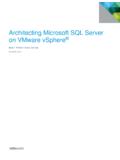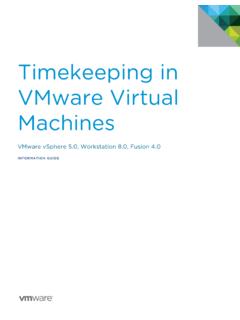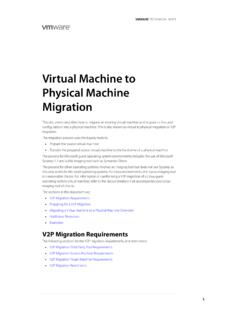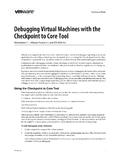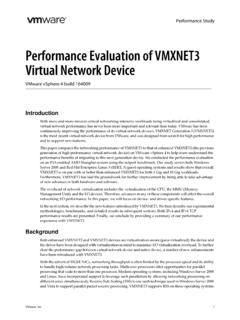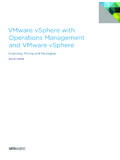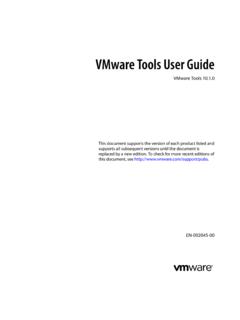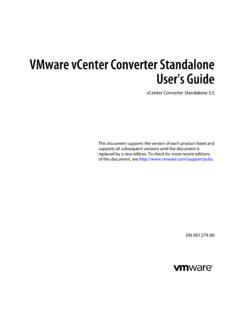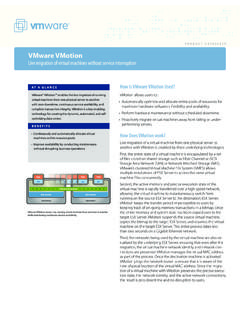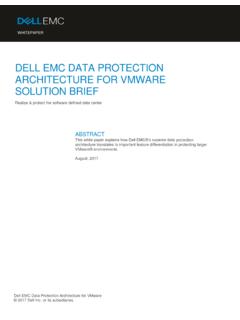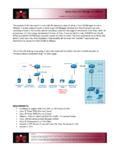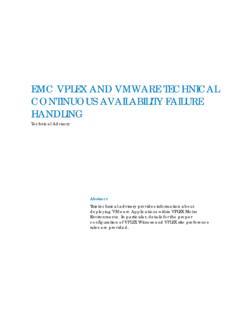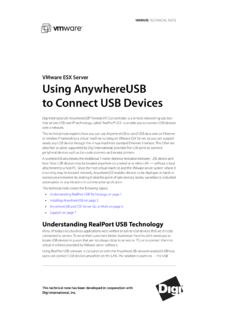Transcription of VDI: A New Desktop Strategy - vmware.com
1 VDI: A New Desktop Strategy A Guide to Managing User Desktop Environmentswith Virtual Desktop Infrastructure W H I T E P A P E RVMware Virtual Desktop Infrastructure VDI A New Desktop Strategy Contents A Brief History of Desktop Execution Early Centralized Distributed Windows Server Based Problems with Terminal Server What is VDI?..3 VDI s Contributions to Desktop VDI offers the Benefits of Server Based VDI offers the Benefits of Distributed New Benefits for Desktop VDI and Desktop VDI Cost Business Drivers and Common Use VDI Design Components for a complete VDI Client Access Secure Client Integrity Checking and Connection Connection Boot Image Application Virtualization and Turbocharged Performance with Data Deployment Scenario 1: Outsourced Scenario 2: Support Solution Managing Hybrid Scenario 3: Local and VDI Apps with Application Customer About the Contents i vmware Virtual Desktop Infrastructure VDI A New Desktop Strategy Introduction Virtual Desktop Infrastructure (VDI) introduces a new way of managing user environments.
2 VDI allows IT administrators to host and administer user desktops on Virtual Infrastructure in the datacenter. Users access their Desktop using a remote Desktop protocol. While sharing similarities with other computing models, VDI offers many new and compelling benefits for increasing manageability, performance, and security of user desktops/PCs. VDI is a solution rather than a product and this paper compares VDI to other user management strategies and highlights VDI s benefits for particular use cases. The paper covers VDI architecture, complimentary third party products and specific design scenarios in order to give the reader a deeper understanding of VDI. Combining the benefits of both distributed and server based computing, VDI provides improved stability, superior performance, and simplified manageability for user desktops in a variety of situations. A Brief History of Desktop Management Management of user desktops has always presented challenges.
3 Several execution models and a variety of management paradigms have attempted to tackle these challenges, each with varying degrees of success. Execution Models Within computing, the relationship between the user interface device and the location of application execution sets the parameters for both performance and manageability of the user environment. Program execution, can be centralized, distributed, or clustered. Each approach brings unique benefits and challenges described below. Early Centralized Computing The expense and complexity of early mainframe based centralized computing excluded consumers and small companies from the benefits of computing technology. As a group, consumers must be able to operate in a stand-alone mode yet seek support for a wide range of software. The confluence of consumer demand for computing, affordable microcomputers and standardized operating systems such as DOS and Windows led to an explosion of software development.
4 Suddenly, application software was a commodity rather than build to order creations of highly skilled programmers. Small to medium sized businesses quickly adopted PC technology as much for access to the diversity of software as for the affordable hardware. Distributed Computing Distributed computing spreads application execution across a number of stand-alone or networked computers to meet the needs of an organization. Until the mid-nineties, the growth in distributed computing seemed unstoppable. Users needed their own PC and there seemed little reason to question this approach while companies enjoyed the new efficiencies brought about by the PC. In the early days of distributed computing, networks were primitive and many companies either lacked appropriate bandwidth and infrastructure or deployed them selectively. PC designers focused their efforts around stand-alone functionality. Networking was more of an add-on than the focus of computing efforts.
5 Slow or unreliable networking made basic design features like the local hard drive a universal and critical feature to maintain any personalization of the PC across reboots. Introduction 1 vmware Virtual Desktop Infrastructure VDI A New Desktop Strategy Distributed computing continues to be the dominant computing model and for this reason, software designers continue to make design and performance assumptions around the PC. Developers often assume that users will have full and exclusive use of their CPUs, memory and hard drives. While Desktop based software generally functions on server platforms, examples of PC centric designs pervade the world of business software. Examples include a CPU pegging at one-hundred percent while programs poll for receipt of data from a remote server. The writing of temporary working files into program directories, or failure to release unused memory also show the bias towards a PC centric design.
6 Key advantages of distributed computing include offline operation and the highest video bandwidth facilitated by the display s close proximity to CPU, memory, and video rendering resources. Windows Server Based Computing Deployed in scale, PCs created an ever-increasing management burden on IT staff. Hardware and software upgrades are frequent, tedious, and error prone. Geographical dispersion amplifies these problems. In the mid-nineties, Citrix pioneered a new approach to managing user environments. Citrix introduced a server based computing model that retained the flexibility of x86 Windows based software while creating opportunities for geographic consolidation and centralized management. Citrix and later Microsoft Terminal Server are similar in their multi-user session aggregation within a single operating system. The management and cost benefits of server based computing have been documented from reputable sources such as the Gartner Group1 and touted by thin client vendors like Wyse2 for many years.
7 The inherent portability, ease of software upgrades and powerful user management tools have continued to make server based computing a popular choice in the enterprise. Until recently, Citrix and Terminal Server based approaches were the only way to access the benefits of centralized computing while using x86 based software. Problems with Terminal Server Designs Windows kernel development has focused on the ability to handle a large variety of applications, facilitate tremendous end-user functionality and accommodate a wide variety of device drivers. The focus on broad functionality has taken the Windows kernel in directions that overlooked the kinds of advanced resource allocation and end-user isolation features necessary to manage demanding multi-user workloads. Adding the multi-user functionality of Terminal Server extensions to the Windows operating system has also magnified issues derived from the single-user general-purpose design of Windows including: Device Driver Incompatibilities: Drivers and devices from different vendors are not regression tested for multi-user shared functionality and unpredicted problems can occur under heavy workloads.
8 Performance Volatility: The longstanding bias in application design towards dedicated PCs leads to assumptions about resource availability that often degrade performance. As the OS supports higher user session densities, unpredictable loads create erratic user experience. CPU intensive applications used simultaneously by a few users can degrade performance for all the other users on a server. Scheduling Limitations: While the Microsoft NT kernel includes many innovations, its focus has not been on sophisticated resource allocation. The NT kernel s thread management limits its ability to balance physical CPU loads. A thread executing in kernel space can tie up processor resources until it exits the kernel and returns to user space. One program or driver can deprive another of CPU time, degrading the user experience under heavy multi-user workloads. 1 Mark A. Margevicius, Michael A.
9 Silver, TCO Comparison of PCs With Server-Based Computing , 15 June 2006 published by The Gartner Group. 2 See Wyse article Thin-Client ROI: The Untold Story , Nov 2005 at A Brief History of Desktop Management 2 vmware Virtual Desktop Infrastructure VDI A New Desktop Strategy Terminal Server based computing continues to grow in popularity as companies recognize the value of server based computing. The performance and compatibility issues of Terminal Server have also limited its. What is VDI? Building on vmware Virtual Infrastructure 3 (VI3), Virtual Desktop Infrastructure (VDI) effectively addresses and resolves key problems in Terminal Server based approaches to server based computing. vmware ESX Server allows multiple user desktops to run as separate virtual machines while sharing underlying physical hardware resources such as CPU, memory, networking and storage. This isolates users from each other, giving each user their own operating system, allowing granular resource allocation and protecting users from application crashes and operation system faults caused by the activities of other users.
10 Taking advantage of ESX Server features and VirtualCenter Server management features, VDI reduces device driver incompatibilities with standardized virtual hardware and a tightly screened Hardware Compatibility List (HCL) for physical ESX Server host hardware. Performance volatility is reduced with ESX Server scalable CPU scheduling and the multi-host balancing of vmware Distributed Resource Scheduler (DRS). vmware ESX Server can halt and reschedule a virtual machine without regard to the activity of threads inside the guest operating system. This creates a more deterministic resource sharing that improves user experience in a VDI environment. In contrast to Terminal Server based centralized computing, Virtual Desktop Infrastructure (VDI) gives each user an independent virtual machine for Desktop computing. Running Citrix, Terminal Server, or any multi-user operating system by itself is not an example of VDI. By giving each user their own operating system, VDI provides the stability and performance management features necessary for enterprise deployment of centralized desktops.
